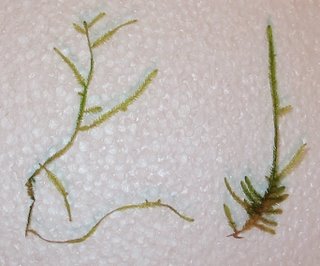Common Name: Christmas Moss, Xmas Moss
Scientific Name: Vesicularia montagnei
Geographic Location: Unknown
Temperature: 65F-77F
pH: 5.0-7.5
Light: Low (1.5WPG) to High (3WPG+)
Growth: Slow
Difficulty: Beginner
Christmas Moss is as mysterious as some of the other mosses in the aquarium hobby. There is no consensus on its geographic origins and even the scientific name has a tendency to change. Its growth habits and appearance are just as varied. When grown attached to a piece of driftwood or rock, it forms triangular fronds in the shape of Christmas trees (hence the common name). If allowed to grow free floating, it tends to have a much less organized appearance and the triangular fronds are much less pronounced. In this form, it is often confused for the much more common Java Moss. In lower light, it grows much less densely, and again, is often much less organized in structure. Only under higher light conditions, attached or anchored to an object, does Christmas Moss show its true structure. It will form a pillowy bush of triangular fronds that is very attractive and undemanding.
This moss is very easy to grow in the aquarium, as it will grow with almost any amount of light. Although not as hardy as the legendary Java Moss, it will survive with low light and no CO2. Growth will not be the ideal structure and will be considerably slower, but it will still live. Like other mosses, Christmas Moss prefers cooler temperatures, under 77F. Over this, it tends to suffer, growing more slowly.
As an aquascaping element, its uses are limited to covering hardscape (rocks, driftwood) or creating a moss wall. A moss wall is created by sandwiching the moss between two pieces of mesh and placing this in the back or sides of a tank. The moss eventually grows through the mesh and covers it up, creating a wall of attractive triangular fronds (as seen in the picture above). It can be used as a carpeting plant, however this is not recommended, as it easily gets choked with mulm and debris and becomes an algae magnet.
Christmas Moss is best bought from other hobbyists who have it growing under ideal conditions in their own aquariums (thus making identification easier). Getting it in a local pet store or online can be risky, as Java Moss can be passed off as Christmas Moss at less than reputable establishments. Christmas Moss can be identified by its more regular branching pattern and slightly different leaf shape. In the picture below, the moss on the left is Java Moss and on the right is Christmas Moss.

Shrimp and fish fry use it as cover and it is also an excellent source of food for both, harboring tiny infusoria (bugs). Overall, Christmas Moss is an excellent plant for covering hardscape, filling in gaps, and creating living backdrops in any aquarium.


I have been looking for some Java or Christmas Moss, does anyone have any that is getting unruly that they would like to give a bit of?
ReplyDeleteExcellent article!
ReplyDeleteThis is far better looking than Java moss (Vesicularia dubyana)
Great information and pictures, well done and thank you very much.
ReplyDelete